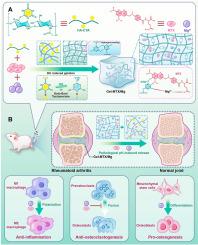基于结构互变异构的超分子载药水凝胶增强类风湿关节炎治疗的药物传递
IF 18
1区 医学
Q1 ENGINEERING, BIOMEDICAL
引用次数: 0
摘要
类风湿性关节炎(RA)是一种主要的自身免疫性疾病,其特征是明显的关节炎症和骨破坏。许多一线RA治疗药物如甲氨蝶呤(MTX)在主要溶剂中的溶解度有限,难以持续递送至RA关节。同时,骨诱导离子如镁离子(Mg2+)的有效共递送治疗RA也具有挑战性,因为不受控制的爆裂释放。通过利用ph诱导的酮烯醇互变异构过程中氰尿酸(CYA)增强的超分子相互作用,提出了一种MTX和Mg2+有效共递送的超分子水凝胶(Gel-MTX/Mg)。该水凝胶具有ph响应性,可在RA关节中释放MTX和Mg2+,这是由病理性ph诱导的CYA酮烯醇互变异构引起的。凝胶-MTX/Mg水凝胶释放MTX和Mg2+,诱导抗炎M2巨噬细胞极化,抑制破骨细胞分化,增强成骨细胞分化。此外,RNA-seq结果显示Gel-MTX/Mg水凝胶促进了与抗炎和骨重塑活动相关的信号通路的富集。在大鼠模型中,一次性关节内给药Gel-MTX/Mg水凝胶可显著抑制炎症症状并保护骨和软骨。这种超分子水凝胶能够同时递送治疗药物和离子以响应病理条件,在治疗类风湿性关节炎和其他炎症性和骨退行性疾病方面具有很大的潜力。本文章由计算机程序翻译,如有差异,请以英文原文为准。

Supramolecular drug-laden hydrogel based on structural tautomerization enhances drug delivery for rheumatoid arthritis treatment
Rheumatoid arthritis (RA) is a major autoimmune disease characterized by significant joint inflammation and bone destruction. Many first-line RA treatment drugs such as methotrexate (MTX) have limited solubility in major solvents and are difficult to be delivered to RA joints in a sustained manner. Meanwhile, the efficient co-delivery of osteoinductive ions such as magnesium ions (Mg2+) for RA treatment is also challenging due to the uncontrolled burst release. By capitalizing on the enhanced supramolecular interactions of cyanuric acid (CYA) upon the pH-induced keto-enol tautomerization, a supramolecular hydrogel (Gel-MTX/Mg) with efficient co-delivery of MTX and Mg2+ is proposed. This hydrogel features pH-responsive on-demand release of MTX and Mg2+ in RA joints triggered by the pathological pH-induced keto-enol tautomerization of CYA. The release of MTX and Mg2+ from the Gel-MTX/Mg hydrogel induces anti-inflammatory M2 macrophage polarization, inhibits osteoclast differentiation, and enhances osteoblastic differentiation. Furthermore, RNA-seq results reveal that the Gel-MTX/Mg hydrogel promotes the enrichment of signaling pathways related to anti-inflammatory and bone-remodeling activities. One-time intra-articular administration of the Gel-MTX/Mg hydrogel significantly suppresses inflammation symptoms and protects bone and cartilage in a rat model. This supramolecular hydrogel that is capable of simultaneously delivering both therapeutic drugs and ions in response to pathological conditions has promising potential for the treatment of RA and other inflammatory and bone-degenerative diseases.
求助全文
通过发布文献求助,成功后即可免费获取论文全文。
去求助
来源期刊

Bioactive Materials
Biochemistry, Genetics and Molecular Biology-Biotechnology
CiteScore
28.00
自引率
6.30%
发文量
436
审稿时长
20 days
期刊介绍:
Bioactive Materials is a peer-reviewed research publication that focuses on advancements in bioactive materials. The journal accepts research papers, reviews, and rapid communications in the field of next-generation biomaterials that interact with cells, tissues, and organs in various living organisms.
The primary goal of Bioactive Materials is to promote the science and engineering of biomaterials that exhibit adaptiveness to the biological environment. These materials are specifically designed to stimulate or direct appropriate cell and tissue responses or regulate interactions with microorganisms.
The journal covers a wide range of bioactive materials, including those that are engineered or designed in terms of their physical form (e.g. particulate, fiber), topology (e.g. porosity, surface roughness), or dimensions (ranging from macro to nano-scales). Contributions are sought from the following categories of bioactive materials:
Bioactive metals and alloys
Bioactive inorganics: ceramics, glasses, and carbon-based materials
Bioactive polymers and gels
Bioactive materials derived from natural sources
Bioactive composites
These materials find applications in human and veterinary medicine, such as implants, tissue engineering scaffolds, cell/drug/gene carriers, as well as imaging and sensing devices.
 求助内容:
求助内容: 应助结果提醒方式:
应助结果提醒方式:


